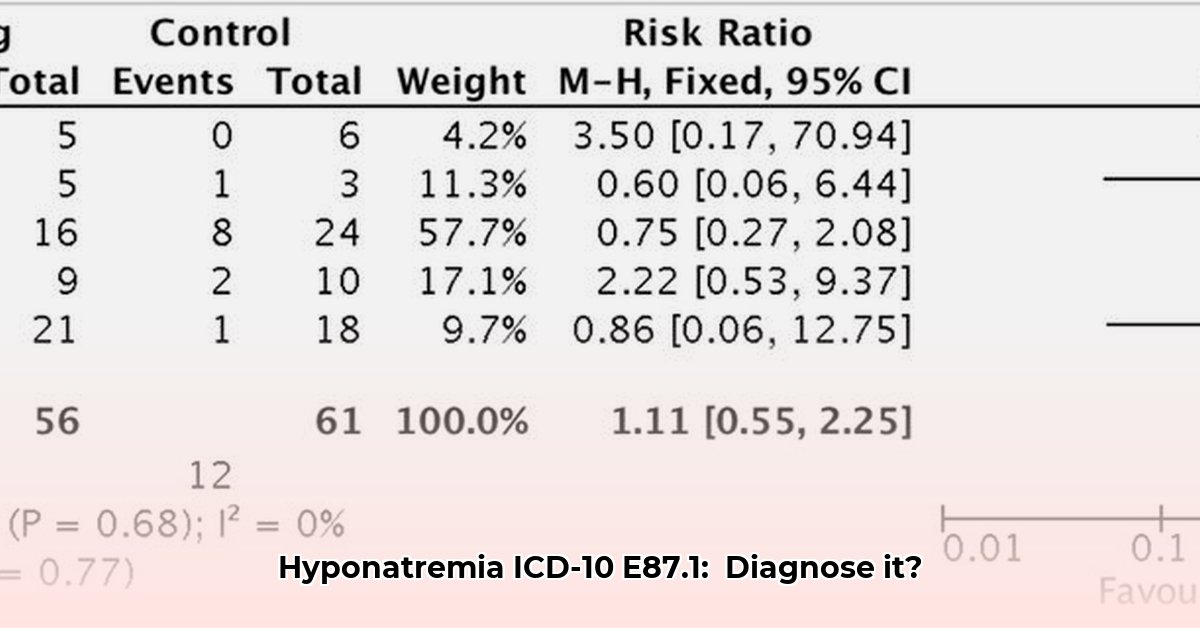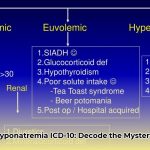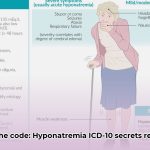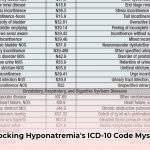Navigating the complexities of ICD-10 coding can be challenging, especially when dealing with conditions like hyponatremia. This guide offers a detailed explanation of ICD-10 code E87.1, providing healthcare professionals, medical coders, and students with a clear understanding of its definition, appropriate usage, diagnostic criteria, and differentiation from related conditions. For more information on hyponatremia coding, see this helpful resource: Hyponatremia ICD-10 Codes.
Understanding ICD-10 Code E87.1: Hypo-osmolality and Hyponatremia
ICD-10 code E87.1, titled “Hypo-osmolality and hyponatremia,” serves as the primary diagnostic code for patients presenting with low sodium levels in the blood (hyponatremia) and a decreased concentration of particles in the blood (hypo-osmolality). This code is generally applied when laboratory blood tests reveal serum sodium levels below 135 mmol/L (millimoles per liter) and serum osmolality under 280 mOsm/kg (milliosmoles per kilogram).
It’s crucial to recognize that E87.1 represents the manifestation of hyponatremia, not the underlying etiology. Therefore, accurate and comprehensive coding necessitates the identification and coding of the underlying cause contributing to the electrolyte imbalance. Failure to identify the underlying cause can lead to inaccurate billing and potentially impact patient care.
Think of E87.1 as an alarm signal; it indicates a problem exists, but further investigation is required to determine the root cause and initiate appropriate treatment.
Diagnostic Criteria and Clinical Presentation of Hyponatremia
The diagnosis of hyponatremia requires a multifaceted approach that integrates clinical assessment with laboratory findings. Key diagnostic elements include:
- Serum Sodium Measurement: A blood test demonstrating serum sodium levels below 135 mEq/L (milliequivalents per liter) is the hallmark of hyponatremia. The severity of hyponatremia is typically classified as mild (130-135 mEq/L), moderate (125-129 mEq/L), or severe (below 125 mEq/L).
- Serum Osmolality: This measurement determines the concentration of dissolved particles (solutes) in the blood, helping to classify the type of hyponatremia. Hypo-osmolality (less than 280 mOsm/kg) indicates hypotonic hyponatremia, which is the most common type.
- Urine Osmolality: Urine osmolality helps differentiate various causes of hyponatremia. Elevated urine osmolality (typically greater than 100 mOsm/kg) suggests the kidneys are inappropriately retaining water, as seen in SIADH. Low urine osmolality (less than 100 mOsm/kg) suggests the kidneys are appropriately excreting water, which can be seen in primary polydipsia.
- Urine Sodium: Measuring sodium concentration in the urine can also aid in determining the cause of hyponatremia. A high urine sodium level (greater than 20 mEq/L) may indicate renal salt wasting or SIADH, while a low urine sodium level (less than 20 mEq/L) may suggest hypovolemia or extrarenal sodium losses.
- Fluid Status: Assessing the patient’s fluid status (euvolemic, hypovolemic, or hypervolemic) helps narrow down the differential diagnosis.
- Clinical Symptoms: Symptoms of hyponatremia can vary widely depending on the severity and rapidity of onset. Mild hyponatremia may be asymptomatic. More severe or rapidly developing hyponatremia can manifest with nausea, headache, confusion, lethargy, muscle cramps, seizures, and even coma.
Thorough and accurate documentation of all these findings is essential for correct coding, appropriate billing, and effective patient management.
Coding Guidelines and Best Practices for E87.1
Adhering to established coding guidelines is crucial for maintaining accurate medical records, ensuring appropriate reimbursement, and facilitating optimal patient care. Consider these best practices when using the E87.1 code:
- Assign E87.1 as the primary diagnosis code when hyponatremia is the primary reason for the encounter.
- Utilize additional ICD-10 codes to specify the underlying cause or associated conditions. Examples include:
- E22.2: Syndrome of inappropriate secretion of antidiuretic hormone (SIADH)
- E23.2: Diabetes insipidus
- E11.65: Type 2 diabetes mellitus with hyperglycemia
- I50.9: Heart failure, unspecified
- N03.9: Chronic glomerulonephritis, unspecified
- Consider the impact of medications on sodium levels. Many medications, such as diuretics, certain antidepressants (SSRIs), and anticonvulsants, can contribute to hyponatremia.
- Carefully review the patient’s medical record for any contributing factors, such as dehydration, renal failure, liver cirrhosis, adrenal insufficiency, or recent surgery.
- Ensure thorough documentation. Detailed clinical notes that clearly link symptoms, laboratory results, and the chosen diagnosis are essential for accurate billing and a complete clinical picture. Including information about the patient’s fluid status, medication list, and relevant medical history strengthens the documentation.
- Query the physician if the underlying cause of hyponatremia is not clearly documented.
Differential Diagnosis: Distinguishing Hyponatremia from Other Conditions
Several conditions can mimic or contribute to hyponatremia, necessitating careful differentiation to ensure appropriate management. Key conditions to consider include:
- Syndrome of Inappropriate Antidiuretic Hormone (SIADH): In SIADH, excessive ADH production leads to water retention and dilutional hyponatremia. Distinguishing features include low serum osmolality, inappropriately elevated urine osmolality, and euvolemia or mild hypervolemia.
- Diabetes Insipidus (DI): In DI, insufficient ADH production (central DI) or resistance to ADH in the kidneys (nephrogenic DI) results in excessive water loss and hypernatremia (high sodium). However, if the patient has ad libitum access to water, they can develop hyponatremia.
- Dehydration: Dehydration leads to a loss of both sodium and water, but the sodium loss is generally proportionally less than water, resulting in elevated sodium (hypernatremia). However, hyponatremia can occur in dehydration if the patient is replacing fluid losses with hypotonic fluids (e.g., water without electrolytes).
- Renal Failure: Impaired kidney function can disrupt sodium regulation, leading to either hyponatremia or hypernatremia depending on the specific type and severity of renal dysfunction.
- Cerebral Salt Wasting (CSW): CSW is a condition that occurs after brain injury or surgery and results in sodium loss and hyponatremia. It is often difficult to differentiate from SIADH.
- Adrenal Insufficiency: Insufficient cortisol production can lead to impaired sodium retention and hyponatremia.
Differentiating between these conditions requires a thorough patient history, physical examination, and comprehensive lab work, including serum and urine osmolality and electrolyte measurements.
Reimbursement Considerations and Common Pitfalls
Accurate coding, including E87.1 and codes for the underlying cause, is critical for avoiding claim denials and revenue loss. However, the specific rules for reimbursement may vary depending on the insurance provider and geographical location. Common pitfalls to avoid include:
- Failing to code the underlying cause of hyponatremia. Many insurance providers require coding the underlying cause for reimbursement.
- Using E87.1 as the only diagnosis code. This can lead to claim denials or reduced reimbursement.
- Not documenting the patient’s fluid status. The patient’s fluid status is an important factor in determining the appropriate treatment for hyponatremia.
- Missing the link between medications and hyponatremia. Always review the patient’s medication list for drugs that can contribute to hyponatremia.
- Not staying up-to-date with the latest coding guidelines. Coding guidelines are updated regularly, so it is important to stay informed of the latest changes.
Always verify local guidelines and payer-specific policies when possible to ensure accurate coding and optimal reimbursement.
Real-Life Examples: Illustrating the Application of E87.1
These examples illustrate how E87.1 is applied in real-world clinical scenarios:
| Case | Serum Sodium (mmol/L) | Serum Osmolality (mOsm/kg) | Fluid Status | ICD-10 Codes | Possible Underlying Cause(s) |
|---|---|---|---|---|---|
| Patient A | 132 | 270 | Euvolemic | E87.1, I50.9 | Heart failure |
| Patient B | 128 | 265 | Euvolemic | E87.1, E22.2 | SIADH due to medication (SSRI) |
| Patient C | 130 | 275 | Hypervolemic | E |
- How Much Do Wellness Programs Cost Businesses To Offer? - December 16, 2025
- Wellness Fair Ideas for Work to Boost Employee Wellbeing - December 15, 2025
- Affordable Employee Wellness Fair Ideas for Any Budget - December 14, 2025
















